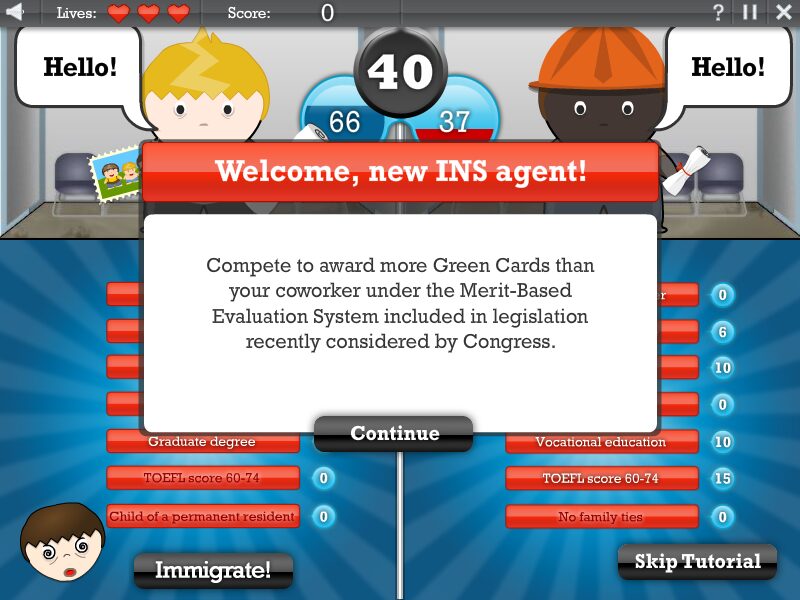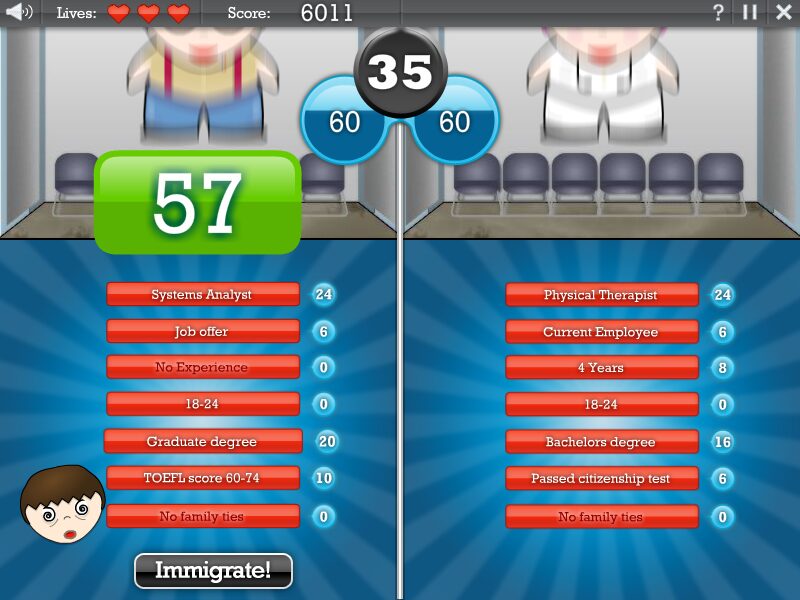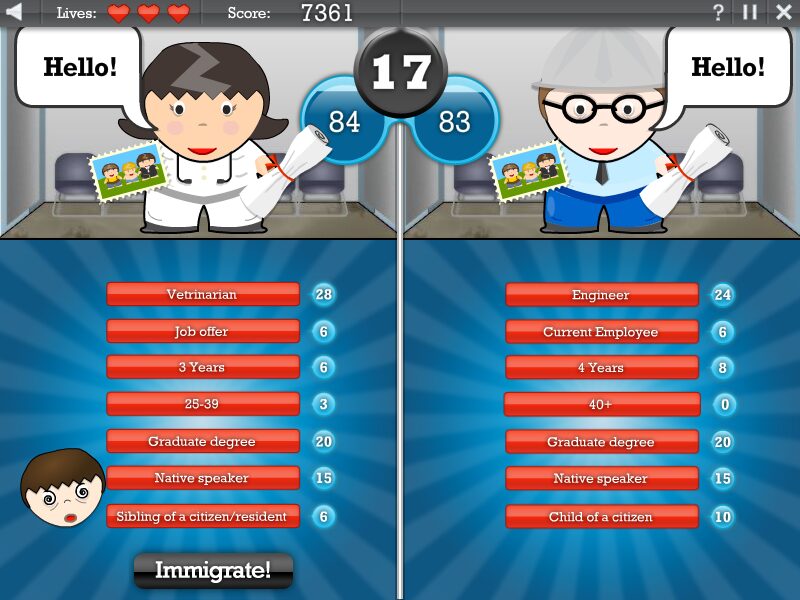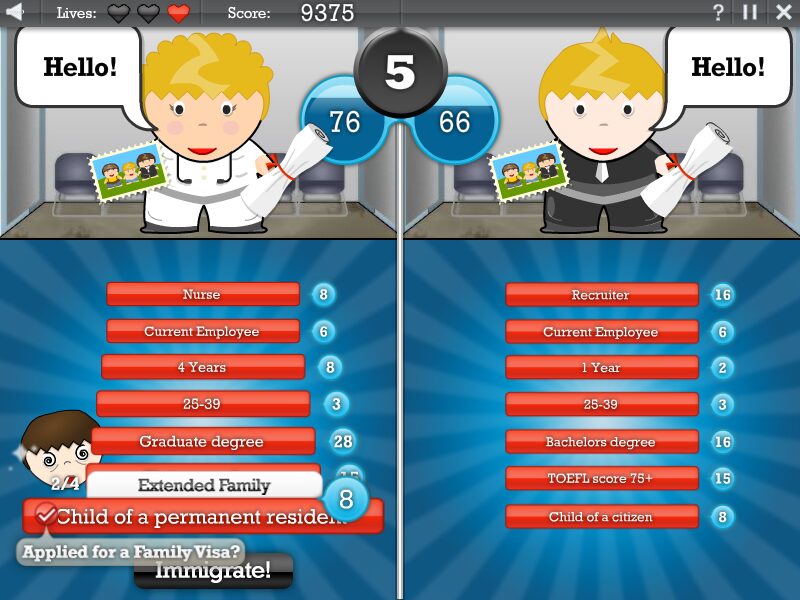Retro Replay Review
Gameplay
Points of Entry frames its core gameplay around a fast-paced, decision-driven simulation where you step into the shoes of a U.S. immigration officer processing visa applications. Each immigrant arrives with a set of attributes—occupation, education level, language proficiency, and family ties—that translate into a numeric value under the Merit-Based Evaluation System (the Kennedy System). Your task is to adjust or “tweak” their profiles in real time, ensuring they meet the visa threshold before the timer runs out. The ticking clock adds urgency, pushing you to balance speed with accuracy.
Opposite you sits a computerized counterpart, another immigration officer whose baseline scores you must match or surpass. This AI opponent introduces a dynamic layer of competition: if you process applicants too slowly or fail to reach the required cut-off, you lose ground in the round. Conversely, perfecting an applicant’s dossier earns you bonus points and edges you ahead. Learning to optimize high-value occupations like doctor or software engineer, while also factoring in familial connections and language skills, becomes a strategic puzzle that tightens with each round.
What elevates the gameplay is its evolving difficulty curve. Early on, you might breeze through simple profiles, but as more complex cases arrive—applicants with mixed qualifications, borderline scores, or specific policy tweaks—you’re forced to think on your feet. The interface remains intuitive throughout, guiding newcomers through the Kennedy System’s point breakdown, yet offers enough depth to keep seasoned players invested. Quick reflexes, keen judgment, and an understanding of immigration policy mechanics all factor into securing top marks.
Graphics
Visually, Points of Entry opts for a clean, streamlined interface that prioritizes clarity over flash. Profiles appear in well-organized cards, each section color-coded to represent different point categories—education in blue, language skills in green, occupation in gold, and family ties in purple. This palette helps you instantly scan and compare attributes, ensuring you can make split-second decisions without hunting for details.
Illustrative icons accompany each category: graduation caps for education, speech bubbles for language proficiency, briefcases for occupations, and family silhouettes for ties. While minimalistic, these graphics convey essential information at a glance. Animations are sparing but effective—a subtle checkmark when an applicant qualifies, a brief red highlight when they fall short, and a smooth slide as new profiles appear, maintaining a brisk pace without clutter.
Performance remains solid across desktop and mobile browsers, reflecting the New York Times’ expertise in delivering responsive web experiences. Load times are negligible, and transitions never stutter, even under tight processing deadlines. Though it doesn’t delve into high-end 3D visuals or cinematic cutscenes, the game’s aesthetic perfectly aligns with its editorial roots: informational, polished, and distraction-free.
Story
Unlike narrative-driven titles, Points of Entry doesn’t weave a traditional storyline. Instead, its “story” unfolds through the real-world context of U.S. immigration policy. Each applicant’s backstory—summarized in a few lines—offers a glimpse into their professional and personal journey. A software engineer from Mumbai, a nurse from Manila, or a culinary specialist from Mexico City each arrives with a name, a brief bio, and the hope of building a life in America.
This educational framing humanizes policy debates. You’re not merely assigning numbers; you’re considering the livelihoods of individuals whose skills and families hang in the balance. As rounds progress, you may find yourself empathizing with applicants who narrowly miss the mark or questioning the fairness of assigning exact point values to complex human experiences. This emotional undercurrent lends the game a quiet resonance.
Moreover, by presenting the Merit-Based Evaluation System in action, the game invites reflection on the strengths and limitations of point-based immigration models. There’s no overarching protagonist or dramatic plot twists—yet each decision carries weight, turning policy abstraction into a series of personal vignettes that collectively tell a broader story about labor markets, language barriers, and familial networks.
Overall Experience
Points of Entry succeeds brilliantly as an educational newsgame: it’s engaging, informative, and surprisingly addictive. The blend of time pressure, strategic decision-making, and real-world policy mechanics creates a compelling loop that keeps you returning for “just one more round.” You’ll come away with a deeper understanding of how a point-based immigration system functions—and the trade-offs that such systems impose on individuals.
This title is ideally suited for policy enthusiasts, educators, and anyone curious about the intersection of gaming and journalism. Teachers can integrate it into civics or social studies curricula to spark discussions on immigration reform, while casual gamers may appreciate its bite-sized challenges and clear learning objectives. The lack of bootcamp-style tutorials means you’ll learn on the fly, but the in-game tooltips and well-labeled categories ensure you never feel lost.
While its appeal may be narrower than blockbuster releases, Points of Entry stands out as an exemplar of purposeful design. By seamlessly weaving data, policy, and user-friendly mechanics, it transforms immigration law into an interactive experience. If you’re looking for a thoughtful simulation that both challenges your analytical skills and broadens your perspective on real-world issues, this newsgame is well worth exploring.
 Retro Replay Retro Replay gaming reviews, news, emulation, geek stuff and more!
Retro Replay Retro Replay gaming reviews, news, emulation, geek stuff and more!









Reviews
There are no reviews yet.